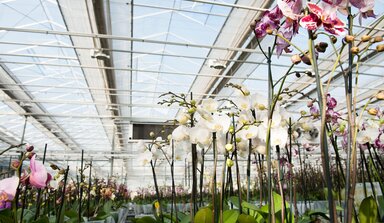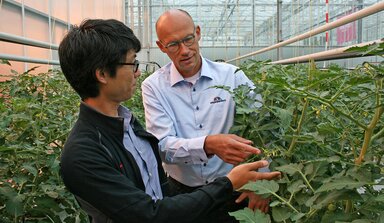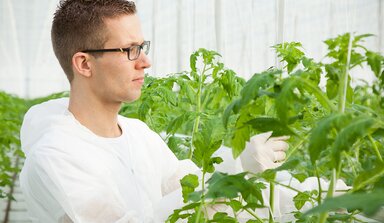More light means a better quality of Phalaenopsis
These days, Phalaenopsis growers are letting more light in. This requires getting the right balance between screens, coatings and humidity.
More light means more photosynthesis resulting in more growth, shorter cultivation times, faster leaf initiation, more flower spikes and faster outgrowth. Too much light is disastrous though. It causes photoinhibition (temporary reduction in photosynthesis) or even irreparable damage to the foliage or buds. For this reason, growers tended to lean towards caution. After a period of experimenting with much higher levels of light, a new cultivation standard seems to have been developed in which coatings play a significant role.
Light intensity
During all phases of cultivation, OK Plant in Naaldwijk has considerably increased the level of light, says crop specialist Leon Kouwenhoven. "In propagation phase 1 we used to use a light intensity of 3.5 to 4 mol/m², whereas now we are at 5.5 mol. We currently use 7 mol during propagation phase 2, 8 during the cooling phase and 8.5 for finishing". He bases the management of the greenhouse on light measurements, finding the light intensity to be a safe gauge, provided a number of other conditions are met. "The humidity needs to be maintained and you have to be very careful about peaks of light, especially when the plants are still weak after emerging from the winter. In that period the light level increases. In the beginning, we filter out excess light using the energy cloth (LS10) and, if necessary, an additional shade cloth", he says. Over the past two years he applied ReduFuse in about week 8, followed by ReduSol in around week 20, depending on the weather forecast.
More relaxed
The company grows small Phalaenopsis species of the Kolibri variety. "With such little plants the ratio between plant, pot and spike length is even more crucial. If the spike is too long, the proportions are lost", he says. "More light means a more compact plant, fleshier leaves, more spikes and buds and faster cultivation, provided you maintain a proper level of humidity, as already stated. As soon as ReduFuse is applied to the roof, the greenhouse is more relaxed, although you still need to filter out the peaks. What is really striking is that the diffused light created by the coating means you no longer see shadow in the greenhouse. The light penetrates deeper into the plant and you remove a certain amount of stress". The company attains a higher quality of plant than ever before. This is down to a combination of higher light intensity, diffused light and other growing factors. "It is hard to say what the contribution of each of these factors is though. You need to keep on making adjustments", he says.

Leon Kouwenhoven
Seeking optimum conditions
Crop consultant René 't Hoen of DLV Plant is seeing more growers that have the same approach as OK Plant: "They apply ReduFuse at around week 8 and add whitewash around Mother's Day. They usually take it off at the beginning of September, although some growers remove it two weeks earlier". Nowadays lots of companies also adopt the same light intensities. "The time of 'more is better' is behind us. During finishing, some companies greatly exceeded 10 mol, but the question is whether the plant actually uses that much light. You also need to take the CAM characteristics of Phalaenopsis into account. It does not absorb any CO2 in the middle of the day", he says. "What's more, there is a lot of discussion surrounding its light use during the day. The photosynthetic efficiency is poorer at the end of the day than it is in the morning. This means you actually have to let more light in in the morning. This can easily be done in summer but in the winter you have to take assimilation lighting into account. New substrates allow cultivation in a more humid environment, which results in a 20-30% growth gain. The question then is whether the light values need to be readjusted to allow for the increased growth.
Light colour
Another issue is light colour. Trials using LEDs have shown that a lot of red light promotes spike induction, even at higher temperatures. You could go from 19ºC to 21ºC, which would mean making savings on cooling. "These kinds of results raise many questions" says 't Hoen. "So, do you have to install LEDs to achieve more red light? I don't think so. In winter, assimilation lighting already emits a lot of red. Furthermore, you could actually filter out the far-red light. This provides opportunities for colour-selective coatings; however, even more research is needed in this area. I also see opportunities for products that go further than the current ones by blocking all non-PAR light". Meanwhile, he thinks it would be wise to use ReduFuse IR during the cooling phase because this coating filters out infrared which changes the red/far-red ratio resulting in better spike induction. Moreover, the cooling section heats up less than with conventional ReduFuse. Despite the consensus on higher lighting levels, in practice the crop consultant sees wide variations in how growing is approached. Companies with outdoor screens only use ReduFuse, which prevents the shadow paths. Companies without outdoor screens often used a diffuse coating in spring and a whitewash in summer. "However, I also know a grower who goes all summer using nothing but ReduFuse IR", he says. "On the other hand, with a low greenhouse it wouldn’t be possible. It is all very much at the development stage and there are no longer any standard formulas".


